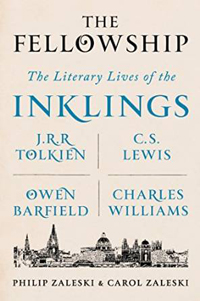 Philip Zaleski and Carol Zaleski, The Fellowship: The Literary Lives of the Inklings (New York: Farrar, Straus and Giroux, 2015), 656pp.
Philip Zaleski and Carol Zaleski, The Fellowship: The Literary Lives of the Inklings (New York: Farrar, Straus and Giroux, 2015), 656pp.
A review by physicist Brad Keister. Brad and his wife Katie worship at Washington Community Fellowship, on Capitol Hill in Washington, DC.
The Fellowship chronicles the paths of four gifted writers — J. R. R. Tolkien, C. S. Lewis, Owen Barfield and Charles Williams — and the crucible in which they altered each others' lives. The Inklings as a group did not have a formal organization with written meeting transcripts. It’s not clear when (1930, give or take a few years) or how the group formed, and it was one of several meeting clubs (including some founded by Lewis), and so the authors of this book have built a narrative using the biographies of the individuals and their known relationships.
What is known is that these four, plus others who migrated in and out, met regularly at Lewis’s rooms at Magdalen College, Oxford, and at the Eagle and Child public house. Their conversations ranged widely over topics of common interest, but what gave the group a legacy was their reading and criticism of works in progress. In the words of C. S. Lewis’s brother Warnie, “We were no mutual admiration society: praise for good work was unstinted, but censure for bad work — or even not-so-good work — was often brutally frank. To read to the Inklings was a formidable ordeal." But these meetings nurtured works like The Hobbit, then Lord of the Rings, and the Narnia chronicles. In those years, Tolkien also subverted the prevailing view of Beowulf in the literary academy and established it as a great work.
The brutal frankness of those meetings extended beyond the literary universe of the Inklings to the very core of deeply held individual beliefs, and challenged their friendships. Indeed, after following the narrative of these talented, strong-willed men (it was apparently a given that women were not admitted, Dorothy Sayers being a notable case), it is perhaps a wonder that the Inklings held together long enough to produce anything of lasting value. All four were Christians, with a meeting of the minds at least at the point of the Nicene Creed. But their differences were profound, and could not be dismissed as academic niceties. As the Zaleskis note: “Tolkien was Catholic; Barfield, Anthroposophist; Lewis, a ‘mere Christian’; Charles Williams, Anglican with a dash of ritual magic.” Their differences in beliefs about first things, and about the very nature and purpose of literature itself, strained their relationships and in turn contributed to the gradual decay of the Inklings, punctuated by Williams’s death in 1945, with the remaining three increasingly occupied by aspects of their separate lives.
So the Inklings represent a point of convergence that occurs from time to time over the course of history — one that brings together a group where the whole is greater than the sum of the parts. According to the Zaleskis, their impact is still working itself out. They provided a return “to the fundamentals of story and exploring its relation to faith, virtue, self-transcendence, and hope,” and “have recovered archaic literary forms not as an antiquarian curiosity but as a means of squarely addressing modern anxieties and longings.”


